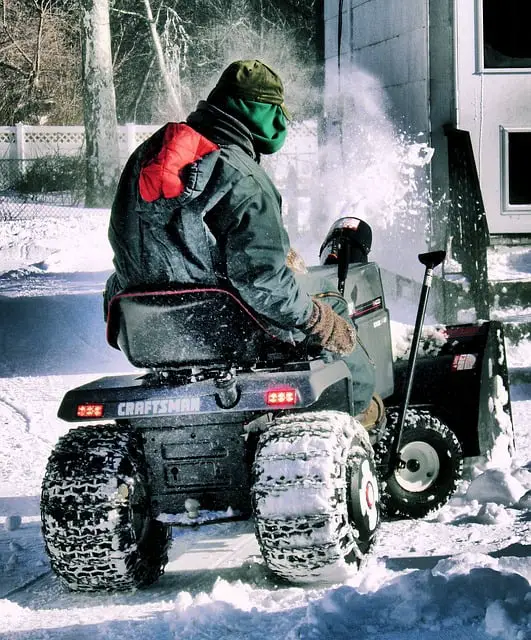A snowblower discharge chute needs to be treated in some way to prevent a build-up of snow and ice from inhibiting its discharge of snow. Without treatment, such a build-up will eventually shut down or damage the machine.
Our next-door neighbors are snowbirds. The people who live in the north in warm weather and fly to Florida when it gets cold. Covid 19 caused them to cancel their migration last year. Snow moved in, and Mick bought a snowblower. I snickered as I watched him get it clogged with ice the first time he used it. Greenhorn!. Then my wife told me to help him. Spoil-sport…
What Didn’t Mick Understand?
A snowblower works by using a powerful auger or drill to move snow and ice. Unlike a drill which moves material up and out, a snowblower’s auger moves the material to the side. The snowblower forces the snow into the discharge chute entrance, where blowers use air to propel it up and out of the chute.
Snow tends to pack, and the wetter the snow, the more tightly it packs. As the auger moves the snow, the weight and pressure of the snow packing squeeze out water. The water may freeze on the auger, or when the blower air hits it in the chute, it may freeze there.
More powerful snowblowers have an additional feature. Impeller blades spin the loose snow moved by the auger. The spin increases the speed of the snow as it enters the chute. Pressure, velocity, moisture, and temperature work together against the snowblower.
As the snow continues to pack and ice forms and sticks, not as much snow can get through the discharge chute entrance. The snowblower continues to work less and less efficiently until the ice and snow bog it down to the point where it ultimately stalls out.
So, We Know the Problem – What’s The Solution?
That was just what Mick asked when I explained why his snowblower wasn’t moving snow. He wasn’t very impressed when I told him it was an ancient Chinese secret, so I let him in on the remedy I used while explaining a few other treatments I knew.
Before I got too far along, I explained the solution was to treat the auger, chute, and impeller blades to prevent a snow and ice build-up. Mick asked what I used, so I told him I rubbed ghost peppers on the metal, and the heat of the peppers melted the snow and ice.
I could tell by the look on his face that Mick did not appreciate my sense of humor.
Should I Use WD-40?
“The solution to our problem is a solution,” I said. Mick’s frustrated grunt made me hurry along. I explained that some people liked to use WD-40 as a treatment. The WD stands for “water displacement.” The solution displaces (removes) water so it can’t freeze on the metal, and the oil in it prevents any further contact of water with the metal.
He thought that sounded great and asked me if I had some. I said no. He looked confused, so I had him look at a couple of spots on his snowblower where there were plastic parts.
I advised him that WD-40 was a solvent that would melt those plastic parts and damage his machine. I let him know that some people are afraid the petroleum distillates in WD-40 will wear or damage the paint on the discharge chute.
He didn’t think WD-40 was a great plan now and asked what else he could use.
Should I Use A Commercial Product?
I told Mick there are quite a few products on the market made explicitly for preventing snow and ice from sticking on surfaces. He was glad to hear that they were safe and would not melt plastic parts. I gave him a few names like DuPont Snow and Ice Repellant, Other SNO-Jet Snow-Jet Snowblower Spray, and Snow Wax Snow and Ice Repellant Coating.
He shook his head and wanted to know how I knew about all those products. I reminded him I owned a hardware store and sold a couple of the products. I told him I had a good idea of their cost, too. When I told him, he asked if there was anything else he could use. Mick has always been a bit of a penny-pincher.
Spray It, Or Wax It?
By this time, my wife had brought us each a mug of hot chocolate. I told Mick of an innovative idea I heard of several years ago as we enjoyed our break.
Some people think WD-40 and commercial products will damage the paint inside the discharge chute, leading to eventual rust and damage. The alternative given by one person was to use ski wax on the paint inside of the discharge chute.
Ski wax is water-resistant and durable. It prevents ice and snow from sticking on a surface and is incredibly slick. It looks nice, too. A few people use it on the outside of the entire snowblower body.
However, it won’t work on an auger or impeller blades.
What Do I Prefer?
Mick’s sense of humor (or was it frustration?) kicked in. He asked, “Okay, so what do you use? By the time we get done here, it’ll be spring!”
I reached into my parka pocket and pulled out a can. “PAM?” he said with surprise in his eyes.
Yes, PAM. PAM is a combination of canola, palm, and coconut oil which provide a lasting waterproof barrier on the surface of any metal. In addition, PAM contains lecithin, an emulsifier. Lecithin attracts moisture and enables it to combine with oil, preventing sticking and a build-up of ice and snow.
The best parts are that PAM is not harmful to paint or plastic parts, and it is much more cost-effective at about $3 a can.
I treated his auger and sprayed his discharge chute, and Mick was off. He slid through the rest of the job quickly, with the help of PAM.


